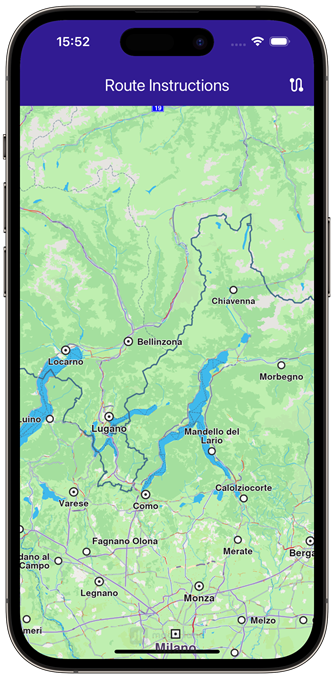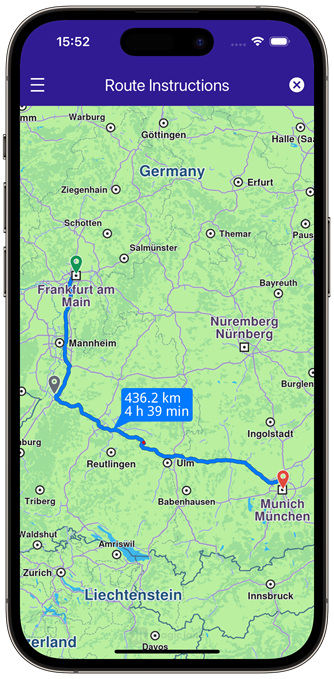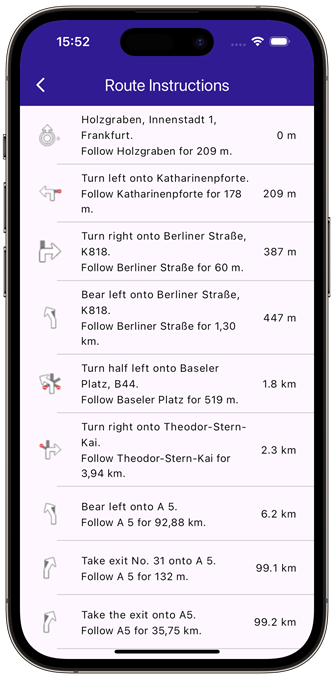Route Instructions
In this guide you will learn how to display a map, calculate routes between multiple points, and show detailed route instructions.
How it Works
This example demonstrates the following key features:
- Display a map.
- Compute a route and simulate navigation.
- Display real-time lane instruction images.
 |  |  |
|---|---|---|
| Initial map view | Calculated route | Route instructions list |
UI and Map Integration
The following code demonstrates how to create a UI featuring a GemMap along with an app bar that includes a "Build Route" button and a "Route Instructions" button. Once a route is calculated, the "Route Instructions" button will appear on the left side of the app bar. Tapping this button navigates the user to a dedicated page displaying detailed route instructions.
class MyApp extends StatelessWidget {
const MyApp({super.key});
Widget build(BuildContext context) {
return const MaterialApp(
debugShowCheckedModeBanner: false,
title: 'Route Instructions',
home: MyHomePage(),
);
}
}
class MyHomePage extends StatefulWidget {
const MyHomePage({super.key});
State<MyHomePage> createState() => _MyHomePageState();
}
class _MyHomePageState extends State<MyHomePage> {
late GemMapController _mapController;
TaskHandler? _routingHandler;
bool _areRoutesBuilt = false;
List<RouteInstruction>? instructions;
void dispose() {
GemKit.release();
super.dispose();
}
Widget build(BuildContext context) {
return Scaffold(
appBar: AppBar(
backgroundColor: Colors.deepPurple[900],
title: const Text("Route Instructions",
style: TextStyle(color: Colors.white)),
actions: [
if (_areRoutesBuilt)
IconButton(
onPressed: _onRouteCancelButtonPressed,
icon: const Icon(Icons.cancel, color: Colors.white),
),
if (!_areRoutesBuilt)
IconButton(
onPressed: () => _onBuildRouteButtonRoute(context),
icon: const Icon(Icons.route, color: Colors.white),
),
],
leading: Row(
children: [
if (_areRoutesBuilt)
IconButton(
onPressed: _onRouteInstructionsButtonPressed,
icon: const Icon(Icons.density_medium_sharp, color: Colors.white),
),
],
),
),
body: GemMap(
key: ValueKey("GemMap"),
onMapCreated: _onMapCreated,
appAuthorization: projectApiToken,
),
);
}
void _onMapCreated(GemMapController controller) {
_mapController = controller;
}
void _onBuildRouteButtonRoute(BuildContext context) {
final departureLandmark =
Landmark.withLatLng(latitude: 50.11428, longitude: 8.68133);
final intermediaryPointLandmark =
Landmark.withLatLng(latitude: 49.0069, longitude: 8.4037);
final destinationLandmark =
Landmark.withLatLng(latitude: 48.1351, longitude: 11.5820);
final routePreferences = RoutePreferences();
_showSnackBar(context, message: 'The route is calculating.');
_routingHandler = RoutingService.calculateRoute(
[departureLandmark, intermediaryPointLandmark, destinationLandmark],
routePreferences, (err, routes) async {
_routingHandler = null;
ScaffoldMessenger.of(context).clearSnackBars();
if (err == GemError.success) {
final routesMap = _mapController.preferences.routes;
for (final route in routes!) {
routesMap.add(route, route == routes.first,
label: route.getMapLabel());
}
_mapController.centerOnRoutes(routes);
instructions = _getInstructionsFromSegments(routes.first.segments);
setState(() {
_areRoutesBuilt = true;
});
}
});
}
void _onRouteCancelButtonPressed() async {
_mapController.preferences.routes.clear();
if (_routingHandler != null) {
RoutingService.cancelRoute(_routingHandler!);
_routingHandler = null;
}
if (instructions != null) {
instructions!.clear();
}
setState(() {
_areRoutesBuilt = false;
});
}
void _onRouteInstructionsButtonPressed() {
Navigator.of(context).push(MaterialPageRoute<dynamic>(
builder: (context) =>
RouteInstructionsPage(instructionList: instructions!)));
}
List<RouteInstruction> _getInstructionsFromSegments(
List<RouteSegment> segments) {
List<RouteInstruction> instructionsList = [];
for (final segment in segments) {
final segmentInstructions = segment.instructions;
instructionsList.addAll(segmentInstructions);
}
return instructionsList;
}
void _showSnackBar(BuildContext context,
{required String message, Duration duration = const Duration(hours: 1)}) {
final snackBar = SnackBar(
content: Text(message),
duration: duration,
);
ScaffoldMessenger.of(context).showSnackBar(snackBar);
}
}
Route Instructions Page
The RouteInstructionsPage displays detailed route instructions. Here is the code for RouteInstructionsPage and the InstructionsItem widget.
class RouteInstructionsPage extends StatefulWidget {
final List<RouteInstruction> instructionList;
const RouteInstructionsPage({super.key, required this.instructionList});
State<RouteInstructionsPage> createState() => _RouteInstructionsState();
}
class _RouteInstructionsState extends State<RouteInstructionsPage> {
Widget build(BuildContext context) {
return Scaffold(
appBar: AppBar(
automaticallyImplyLeading: true,
title: const Text(
"Route Instructions",
style: TextStyle(color: Colors.white),
),
backgroundColor: Colors.deepPurple[900],
foregroundColor: Colors.white,
),
body: ListView.separated(
padding: EdgeInsets.zero,
itemCount: widget.instructionList.length,
separatorBuilder:
(context, index) => const Divider(indent: 50, height: 0),
itemBuilder: (contex, index) {
final instruction = widget.instructionList.elementAt(index);
return InstructionsItem(instruction: instruction);
},
),
);
}
}
class InstructionsItem extends StatefulWidget {
final RouteInstruction instruction;
const InstructionsItem({super.key, required this.instruction});
State<InstructionsItem> createState() => _InstructionsItemState();
}
class _InstructionsItemState extends State<InstructionsItem> {
Widget build(BuildContext context) {
return ListTile(
leading: Container(
padding: const EdgeInsets.all(8),
width: 50,
child:
widget.instruction.turnImg.isValid ?
Image.memory(
widget.instruction.turnDetails.getAbstractGeometryImage(
renderSettings: AbstractGeometryImageRenderSettings(),
size: Size(100, 100),
)!,
)
: SizedBox(),
),
title: Text(
widget.instruction.turnInstruction,
overflow: TextOverflow.fade,
style: const TextStyle(
color: Colors.black,
fontSize: 14,
fontWeight: FontWeight.w400,
),
maxLines: 2,
),
subtitle: Text(
widget.instruction.followRoadInstruction,
overflow: TextOverflow.fade,
style: const TextStyle(
color: Colors.black,
fontSize: 14,
fontWeight: FontWeight.w400,
),
maxLines: 2,
),
trailing: Text(
widget.instruction.getFormattedDistanceUntilInstruction(),
overflow: TextOverflow.fade,
style: const TextStyle(
color: Colors.black,
fontSize: 14,
fontWeight: FontWeight.w400,
),
),
);
}
}
This example guides you through the setup and implementation of route instructions in a Flutter application using the Maps SDK for Flutter. The focus is on handling maps, user interactions, and route preferences to provide a seamless user experience for calculating and displaying route instructions.
Flutter Examples
Maps SDK for Flutter Examples can be downloaded or cloned with Git.